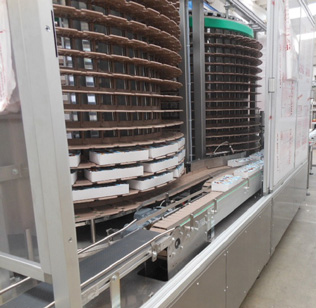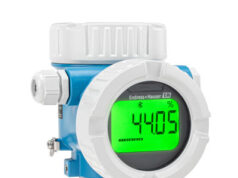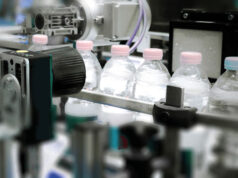 Soluzioni di M.H. Material Handling per l’efficienza produttiva
Soluzioni di M.H. Material Handling per l’efficienza produttiva
La ricerca della massima efficienza nelle linee di confezionamento richiede soluzioni che permettano di compensare le inevitabili micro fermate che si possono verificare nelle varie macchine della catena. Al crescere delle cadenze produttive diventa fondamentale avere a disposizione buone capacità di accumulo per evitare di dover fermare la produzione a monte, specialmente in presenza di processi che non possono essere interrotti istantaneamente o addirittura non possano essere fermati affatto (un tipico esempio potrebbe essere quello di un forno industriale).
M.H. Material Handling risponde a queste esigenze con i sistemi di accumulo BAT Buffer e Heliflex.
Entrambi i prodotti sono buffer di tipo LIFO (Last In First Out):
• BAT Buffer utilizza la catena a tapparella BAT, la struttura è composta da spire con tratti rettilinei di lunghezza variabile tra 2,5 e 6 metri e curve a raggio medio di 200 mm per contenere al massimo l’ingombro laterale. Il buffer è capace di raggiungere lunghezze fino a 150 m (estendibili affiancando altre spirali).
• Heliflex utilizza invece una speciale catena con struttura a sbalzo e autoportante, avvolta su due tamburi, salendo su uno e scendendo sull’altro raggiungendo una capacità massima di 700 m per le macchine di maggiori dimensioni.
Per entrambi i sistemi l’inserimento dei prodotti avviene tramite un sistema di devio a movimentazione pneumatica posto sulla linea principale che, al momento dello stop della macchina a valle, dirige i prodotti in arrivo verso il buffer.
Il movimento della catena è controllato grazie all’azione di un inverter, questo consente di inserire i prodotti sul buffer controllando il passo in modo che non entrino in contatto tra loro mantenendo la pressione zero ed evitando possibili danneggiamenti, pur ottimizzando al massimo lo spazio disponibile.
Nel momento in cui la macchina a valle si rende nuovamente disponibile o nel caso in cui si fermi la produzione a monte, il buffer inverte il proprio senso di marcia ed entra in fase di scarico.
Il reinserimento in linea dei prodotti può avvenire in due modi, la cui scelta è legata al mantenimento o meno del senso di marcia rispetto al momento dell’inserimento.
• Nel caso in cui i prodotti debbano necessariamente mantenere il senso di marcia con cui sono entrati nel buffer, è previsto un sistema di restituzione dei prodotti tramite trasferitore ortogonale, pneumatico o motorizzato.
• Nel caso in cui il senso di marcia dei prodotti risulti indifferente ai fini della produzione, la restituzione può avvenire tramite devio fisso su di un nastro di scarico e quindi tramite un sistema di unificazione con la linea principale.
LIFO buffer systems
M.H. Material Handling solutions for production efficiency
The search for maximum efficiency in the packaging lines requires solutions that make it possible to compensate for the inevitable idle stops that can occur in the various machines in the chain. As production rates increase, it becomes essential to have good buffering spaces available to avoid having to stop production upstream, especially in the presence of processes that cannot be interrupted instantly or even cannot be stopped at all (a typical example could be that of an industrial oven).
M.H. Material Handling meets these needs with the BAT Buffer and Heliflex accumulation systems.
Both products are LIFO (Last In First Out) type buffers:
• BAT Buffer uses the BAT table top chain; the structure of the machine is composed of spires with straight sections of variable length between 2.5 and 6 meters and curves with an average radius of 200 mm to minimize the lateral dimensions. The buffer is capable of reaching lengths up to 150 m (which can be extended adding other spirals side by side).
• Heliflex instead uses a special chain with a cantilevered and self-supporting structure, wound on two drums, climbing on one and descending on the other, reaching a maximum capacity of 700 m for larger machines.
For both systems, product insertion takes place via a pneumatic movement diverter system placed on the main line which, when the downstream machine stops, directs the incoming products to the buffer.
The movement of the chain is controlled thanks to the action of an inverter, this allows the insertion of the products on the buffer by controlling the pitch so that they do not come into contact with each other, maintaining zero pressure and avoiding possible damage, while maximizing the available space.
When the downstream machine becomes available again or in the event that upstream production stops, the buffer reverses its direction of travel and begins the unloading phase.
The re-insertion of products online can take place in two ways, the choice of which is linked to whether or not the direction of travel is maintained with respect to the time of insertion.
• In the event that the products must necessarily maintain the direction of travel in which they entered the buffer, a product return system is provided by means of an orthogonal, pneumatic or motorized transfer device.
• In the event that the direction of movement of the products is indifferent to production purposes, the return can be made by means of a fixed deviation on an unloading belt and therefore by means of a unification system with the main line.









